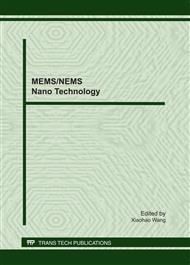p.3
p.9
p.14
p.18
p.23
p.34
p.38
p.43
Design and Empirical Study for Coner Compensation in 25% Wt TMAH Etching on (100) Silicon Wafers
Abstract:
Anisotropic wet etching is a key processing step for the fabrication of microstructures. In general, convex corner structures and non {111} crystal planes will be undercut during wet anisotropic etching. This characteristic of Si is an obstacle to the fabrication of structures in various applications. Among a number of silicon etchants, TMAH is becoming popular for low toxicity and CMOS compatibility. In this paper, a new design of compensation structure has been proposed to solve the undercutting problem with 25%wt TMAH solution. The new compensation structure is made up by squares which are connected to the convex corner. An empirical expression between the parameters of the new compensation structure and etching depth is derived. The changes of the compensation structure in different etching process are shown by photographs. Experimental results prove the high accuracy of this method. Compared to two widely used compensation structures, the new structure is more space efficient.
Info:
Periodical:
Pages:
9-13
Citation:
Online since:
June 2011
Authors:
Price:
Сopyright:
© 2011 Trans Tech Publications Ltd. All Rights Reserved
Share:
Citation:


